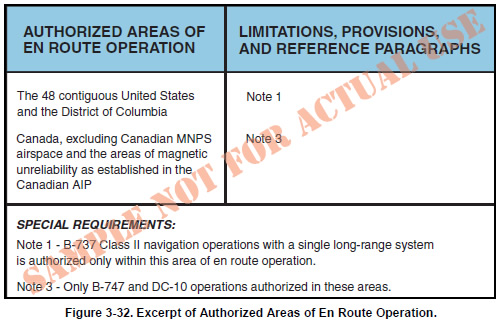|
DIVERSION PROCEDURES
Operations Specifications (OpsSpecs) for commercial
operators include provisions for en route emergency
diversion airport requirements. Operators are expected
to develop a sufficient set of emergency diversion airports,
such that one or more can be reasonably
expected to be available in varying weather conditions.
The flight must be able to make a safe landing,
and the airplane maneuvered off of the runway at the
selected diversion airport. In the event of a disabled
airplane following landing, the capability to move the
disabled airplane must exist so as not to block the
operation of any recovery airplane. In addition, those
airports designated for use must be capable of protecting
the safety of all personnel by being able to:
- Offload the passengers and flight crew in a safe
manner during possible adverse weather conditions.
- Provide for the physiological needs of the passengers
and flight crew for the duration until safe
evacuation.
- Be able to safely extract passengers and flight
crew as soon as possible. Execution and completion
of the recovery is expected within 12 to 48
hours following diversion.
Part 91 operators also need to be prepared for a diversion.
Designation of an alternate in the IFR flight
plan is a good first step; although, changing weather
conditions or equipment issues may require pilots to
consider other options.
EN ROUTE RNAV PROCEDURES
RNAV is a method of navigation that permits aircraft
operations on any desired course within the coverage
of station-referenced signals, or within the limits of
self-contained system capability. The continued growth
in aviation creates increasing demands on airspace
capacity and emphasizes the need for optimum utilization
of available airspace. These factors, allied with the
requirement for NAS operational efficiency, along with
the enhanced accuracy of current navigation systems,
resulted in the required navigation performance (RNP)
concept. RNAV is incorporated into RNP requirements.
OFF AIRWAY ROUTES
Part 95 prescribes altitudes governing the operation of
your aircraft under IFR on Federal airways, jet routes,
RNAV low or high altitude routes, and other direct
routes for which an MEA is designated in this regulation.
In addition, it designates mountainous areas and
changeover points. Off-airway routes are established
in the same manner, and in accordance with the same
criteria as airways and jet routes. If you fly for a scheduled
air carrier or operator for compensation or hire,
any requests for the establishment of off-airway routes
are initiated by your company through your principal
operations inspector (POI) who works directly with
your company and coordinates FAA approval. Air carrier
authorized routes are contained in the company’s
OpsSpecs under the auspices of the air carrier operating
certificate. [Figure 3-32]

Off-airway routes predicated on public navigation
facilities and wholly contained within controlled airspace
are published as direct Part 95 routes. Off-airway
routes predicated on privately owned navigation facilities
or not contained wholly within controlled airspace
are published as off-airway non-Part 95 routes. In evaluating
the adequacy of off-airway routes, the following
items are considered; the type of aircraft and navigation
systems used; proximity to military bases, training
areas, low level military routes; and the adequacy of
communications along the route. If you are a commercial
operator, and you plan to fly off-airway routes,
your OpsSpecs will likely address en route limitations
and provisions regarding en route authorizations to use
the global positioning system (GPS) or other RNAV
systems in the NAS. Your POI must ensure that your
long-range navigation program incorporates the
required practices and procedures. These procedures
must be in your manuals and in checklists, as appropriate.
Training on the use of long range navigation
equipment and procedures must be included in your
training curriculums, and your minimum equipment
lists (MELs) and maintenance programs must address
the long range navigation equipment. Examples of
other selected areas requiring specialized en route
authorization include the following:
- Class I navigation in the U.S. Class A airspace
using area or long range navigation systems.
- Class II navigation using multiple long range
navigation systems.
- Operations in central East Pacific airspace.
- North Pacific operations.
- Operations within North Atlantic (NAT) minimum
navigation performance specifications
(MNPS) airspace.
- Operations in areas of magnetic unreliability.
- North Atlantic operation (NAT/OPS) with two
engine airplanes under Part 121.
- Extended range operations (ER-OPS) with two
engine airplanes under Part 121.
- Special fuel reserves in international operations.
- Planned inflight redispatch or rerelease en route.
- Extended over water operations using a single
long-range communication system.
- Operations in reduced vertical separation minimum
(RVSM) airspace.
|

